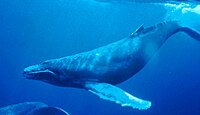
Photo from wikipedia
Abstract Marine mammals are impacted by many anthropogenic activities and mitigating these impacts requires knowledge about the geographic occurrence of threats. Here, we systematically reviewed, categorized and geo-referenced information from… Click to show full abstract
Abstract Marine mammals are impacted by many anthropogenic activities and mitigating these impacts requires knowledge about the geographic occurrence of threats. Here, we systematically reviewed, categorized and geo-referenced information from >1780 publications about threats affecting 121 marine mammal species worldwide between 1991 and 2016. We created risk maps by assigning threat to countries where they had been reported, further refining spatial allocation to specific ocean basins and Longhurst biogeographical provinces and subsequent intersection with mapped species' distributions. We superimposed risk maps for different taxa and threats to visualize geographic patterns of risks and quantify risk severity with respect to number of species affected. Almost all marine mammal species have been reported to face at least one threat. Incidental catch affected the most species (112 species), followed by pollution (99 species), direct harvesting (89 species) and traffic-related impacts (86 species). Direct human activities, mainly fisheries, urban development, whaling/hunting and tourism were the major source of threats affecting most species (>60 species). Risk areas were identified for 51% of marine mammal core habitat. Besides, the majority of local marine mammal communities are at high-risk in 47% of world coastal-waters. Hotspots were located mainly in temperate and polar coastal waters and in enclosed seas such as the Mediterranean or Baltic Sea. However, risk areas differed by threat types and taxa. Our maps show that human activities in coastal waters worldwide impose previously unrecognized levels of cumulative risk for most of marine mammal species, and provide a spatially explicit frame of reference for the assessment of mammals' species conservation status.
Journal Title: Biological Conservation
Year Published: 2018
Link to full text (if available)
Share on Social Media: Sign Up to like & get
recommendations!